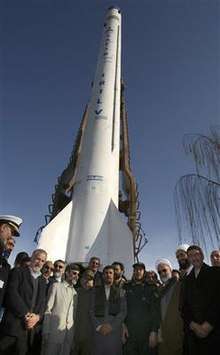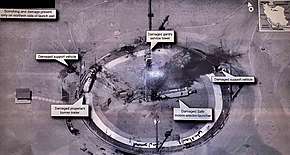Safir (rocket)
The Safir (Persian: سفیر, meaning "ambassador") is the first Iranian expendable launch vehicle able to place a satellite in orbit.[2] The first successful orbital launch using the Safir launch system took place on 2 February 2009 when a Safir carrier rocket placed the Omid satellite into an orbit with a 245.2 km (152.4 mi) apogee.[3][4]
 Prior to the 2 February 2009 launch with Omid on board | |
| Function | LEO launch vehicle |
|---|---|
| Manufacturer | Iranian Space Agency |
| Country of origin | Iran |
| Size | |
| Height | 22 m (72ft) |
| Diameter | 1.25 m (4.10ft) |
| Mass | 26,000 kg |
| Stages | 2 |
| Capacity | |
| Payload to LEO | 65 kilograms (143 lb)[1] |
| Associated rockets | |
| Family | Shahab |
| Launch history | |
| Status | Operational |
| Launch sites | Iran Space Center |
| Total launches | 8 (attempted) |
| Successes | 4 |
| Failures | 1 (3 unknown) |
| First flight | 17 August 2008 |
| Last flight | 5 February 2019 |
The Simorgh is a larger launcher based on Safir technology, and sometimes called the Safir-2.[5]
Kavoshgar
A sub-orbital test flight, named Kavoshgar-1 (Persian: کاوشگر ۱, "Explorer-1"), was conducted on 4 February 2008, as announced by state-run television. A launch on 25 February 2007 may also have been of the same type. The first flights carried instruments to measure the higher atmosphere. The rocket launched on 4 February 2008 was a liquid-propellant-driven rocket, probably a derivative of the Shahab-3, that reached an altitude of 200–250 km in space, and successfully returned science data according to the Iranian News Agency.
On 19 February 2008, Iran offered new information about the rocket and announced that Kavoshgar-1 used a two staged rocket.[6] The first stage separated after 100 seconds and returned to earth with the help of a parachute. The second stage continued its ascent to an altitude of 200 kilometres. However it was not intended to reach orbital velocity.
Earlier reports by the Iranian News Agency suggested that Kavoshgar-1 used a three staged rocket with the first stage separating after 90 seconds and the rocket reaching an orbit between 200 and 250 kilometres.[7][8]
The successful development and launch of a sounding-space-rocket was already announced a year earlier, on 25 February 2007. It is unknown if the sounding rocket launched on 25 February 2007 and the rocket launched on 4 February 2008 are of the same type.
Launch history

Safir has made seven launches so far, putting 4 satellites into orbit.
| Flight No. | Date & Time (UTC) | Payload | Type | Outcome | Remarks |
|---|---|---|---|---|---|
| 1 | 17 August 2008 | Unknown; may be boilerplate | Safir-1 | Unknown | US defense officials claimed the vehicle failed after first-stage powered flight; Iranian officials claimed that the launch was a suborbital test carrying a boilerplate satellite.[9][10] |
| 2 | 2 February 2009 | Omid | Safir-1 | Success | First successful orbital launch of Safir making Iran the ninth country to develop an indigenous satellite launch capability.[11] |
| 3 | 15 June 2011 | Rasad | Safir-1A | Success | Rasad-1 was launched on the maiden flight of the Safir-1B with increased thrust. |
| 4 | 3 February 2012 | Navid | Safir-1B | Success | New configuration of the Safir carrier rocket, featuring a larger second stage with 20% more thrust. |
| 5 | Between 18 May and 21 June 2012 | Unknown | Safir-1B+ | Failure | Satellite imagery shows a blast scar on launch pad, suggesting that there has been a launch. No officials have confirmed a launch. It may have been either an engine test or rocket failure at high altitude.[5] |
| 6 | 2 February 2015 | Fajr | Safir-1B+ | Success | First Iranian satellite with orbital maneuverability using cold-gas thrusters. |
| 7 | 5 February 2019 | Doosti (Friendship) | Safir-1B+ | Failure | The Deputy Minister of Defense in Iran claimed a successful launch.[12] Research associates at the Middlebury Institute of International Studies claimed the launch failed at some point after liftoff.[13] |
| 8 | 29 August 2019 | Nahid 1 | Safir-1B+ | Failure | Launch preparation accident.[14][15] |
See also
- International rankings of Iran in Science and Technology
- Asian space race
References
- http://jamejamonline.ir/newstext.aspx?newsnum=100803210565
- Parisa Hafezi (2008-08-17). "Iran launches first home-made satellite into space". Reuters. Retrieved 2008-08-17.
- "OMID Spacecraft - Trajectory Details". NASA NSSDC.
- "The Threat". US Missile Defense Agency. Archived from the original on 2009-11-05.
- Clark, Stephen (11 February 2019). "Second Iranian satellite launch attempt in a month fails". Spaceflight Now. Retrieved 12 February 2019.
- "Iran provides space launch info". Press TV. 2008. Archived from the original on 2008-09-30. Retrieved 2009-01-11.
- Ali Akbar Dareini (2008). "Iran to Launch 2 More Research Rockets Before Placing Satellite into Orbit This Summer". Space.com. Archived from the original on 2009-02-08. Retrieved 2009-01-11.
- "Iran's Research Rocket Beams Back Science Data". Associated Press. 2008. Retrieved 2009-01-11.
- "Iran launches satellite carrier". BBC News. 2008-08-17. Retrieved 2008-08-17.
- "Safir Data Sheet". Space Launch Report. 6 February 2018. Retrieved 19 March 2018.
- McDowell, Jonathan. "Issue 606". Jonathan's Space Report. Retrieved 2009-02-03.
- "Иран запустил второй за месяц спутник собственного производства". РИА Новости (in Russian). 2019-02-07. Retrieved 2019-02-07.
- Brumfiel, Geoff (2019-02-06). "Satellite Imagery Suggests 2nd Iranian Space Launch Has Failed". NPR.org. Retrieved 2019-02-07.
- Iranian Rocket Launch Ends In Failure, Imagery Shows npr.org
- Iran rocket launch failure satellite photo space.com
External links
| Wikimedia Commons has media related to Safir. |
- Iran's Research Rocket Beams Back Science Data, Space.com
- Iran Launches Rocket, Unveils Space Center, Space.com
- Iran's Sputnik, SpaceRef.com
- Iran rocket claim raises tension, BBC
- Iran: Rocket Launch Another Show Of Prowess, RadioFreeEurope RadioLiberty
- Iran claims space rocket launch, AlJazeera
- Iranians inaugurate space project, BBC
- Iran to Launch 2 More Research Rockets Before Placing Satellite into Orbit This Summer, on Space.com
- Iran Launches Indigenous Carrier Rocket